By Ben DiDonato
There is a long-running debate in the United States Navy over building smaller aircraft carriers. These arguments generally focus on cost and hull count. Rather than dive into these arguments and attempt to argue for what should be done, we will instead explore how we use these arguments to rethink requirements and produce a more robust concept.
A new thought process illustrated here in the context of a small aircraft carrier is applicable to many other complex problems. As such, while a hypothetical design for a small carrier to supplement the current supercarrier fleet will be presented, part of its purpose is to illustrate how this thought process can proceed to unconventional conclusions. The question remains as to whether the merits of this design justify its substantial cost, and follow-on studies and wargaming may be required to explore this concept further.
How Can We Make a Smaller Carrier?
In order to determine the requirements for a small carrier, we must begin with the requirements for a modern supercarrier. Fortunately, the one-sentence mission statement for the Ford-class carriers defined this clearly:
“The critical capability of the aircraft carrier is that the aircraft carrier’s air wing must simultaneously perform surveillance, battlespace dominance, and strike and sustain combat operations forward.”
Form must follow function, and studies repeatedly show ‘bigger is better’ according to this mission statement. If we want to make a smaller carrier viable we must find a way to alter that mission statement without rendering the resulting carrier irrelevant.
This discussion focuses on omitting ‘strike’ from the mission statement. This does not mean the carrier will be completely incapable of performing strike missions, but it does mean any strike capability will be largely incidental and context-dependent. While omitting the strike mission may be jarring to the modern Navy, it has a strong historical precedent in the escort carriers of the Second World War, and was revisited in the Sea Control Ship concept of the 1970s. Like these historical examples, this ship would primarily be an escort with a focus on protecting convoys, and feature extensive anti-submarine capabilities. However, it could also perform other missions like forward surveillance, chokepoint defense, and troop support.
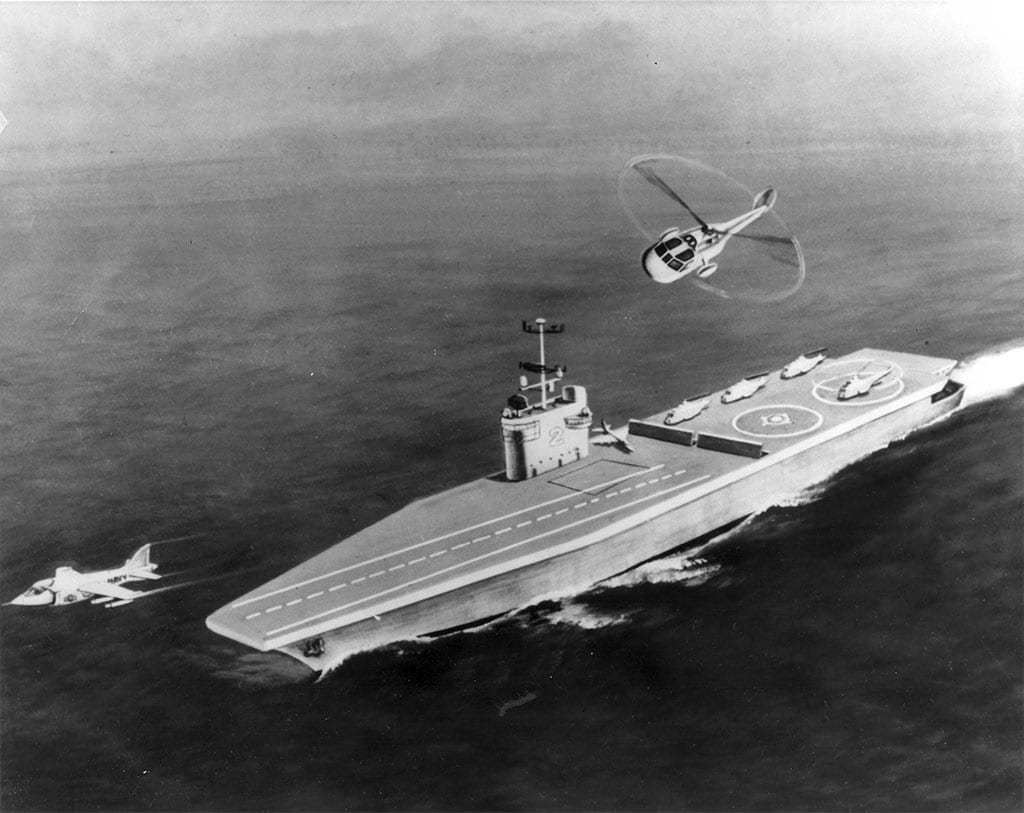
Most critically, the removal of the ‘strike’ objective from its mission statement means that the carrier is no longer expected to divide its limited air wing capacity. This bypasses the otherwise crippling weakness commonly referred to as ‘the small carrier problem,’ where having a small air wing forces a hard choice between offense and defense. By changing goals and expectations in this manner, we can tailor the ship and its air wing for defensive operations and leave major strike operations to the supercarrier fleet. It should also be remembered that this omission does not preclude offensive operations because the ship could be sent forward in certain contexts.
One issue that limited the utility of the Sea Control Ship was the aircraft of the day, especially the Harrier. Unlike the modern F-35B, the Harrier had serious deficiencies in air combat capability, range, and payload. These deficiencies resulted in a relatively inflexible air wing. A modern small carrier would be much more capable thanks to the improvements the F-35 brings to the table. It is fully capable of defending the carrier from air attack, has the range to intercept targets, and the payload to strike targets if the opportunity arises. The F-35’s sensors and networking also let it perform many tasks which previously required a dedicated early warning aircraft, allowing it to replace the helicopters envisioned for this mission on the Sea Control Ship. It may not provide the same degree of situational awareness as a dedicated platform like the E-2D, but it is far more survivable and does not give the enemy a large, easily detected radar signature to point them toward the ship.
The Escort Problem
The other major factor in any discussion of carriers is the cost of escorts. Even if serious savings were reaped in fielding the carrier itself, immense costs are incurred by fielding a major combatant that necessitates additional escorting platforms.
An undesirable solution to this problem is to reduce the number of supercarriers in the fleet to free up escorts for the new ships. This might come from the concentration of even more aircraft into a substantially larger class of future CVNs, generating savings by exploiting the efficiency of very large carriers. However, this option is inherently limited since it would allow the addition of only a handful of smaller carriers. This approach will not be discussed further here, but future fleet composition studies should closely examine the possibility of even larger supercarriers, since that has been largely omitted in recent studies.
Another less conventional solution is to take a page out of the Soviet playbook by adding a heavy weapons and sensor suite to allow the ship to potentially defend itself without escorts. Modern weapon and sensor systems have substantially reduced the design conflicts associated with this concept. This helps address the historical Sea Control Ship’s inability to defend itself against anti-ship missiles, and substantially improves the flexibility of the resulting ship.
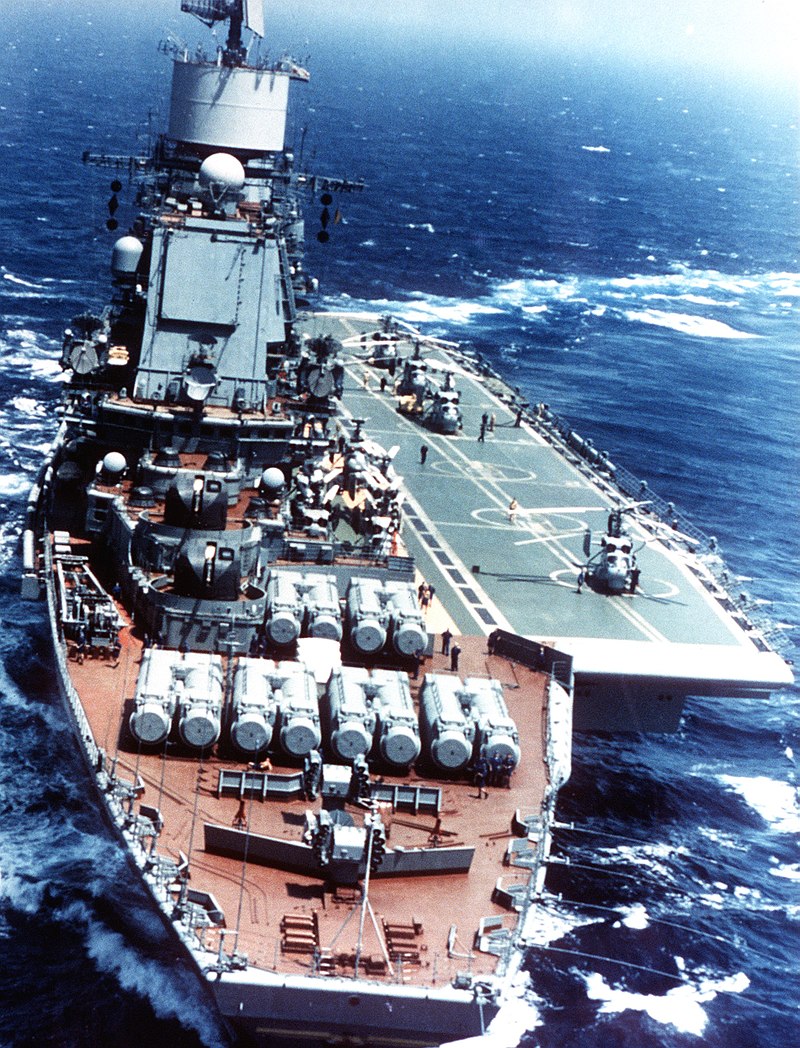
A Hypothetical Design
Now that we have established the mission and design goals, we will move into the hypothetical design process starting with the hull.
Since convoy escort is the primary mission, and there is no need to keep up with the supercarriers, a top speed in the 20-to-25 knot range should meet mission requirements. The ship will be some combination of the Arleigh Burke-class destroyer and the historical Sea Control Ship plans, so adding these two vessels’ displacement together for 20,000 to 30,000 tons is a reasonable estimate for this modern escort carrier. The San Antonio-class amphibious transport dock fits into this range, so its base hull and propulsion plant form the basis of this concept, and the superstructure will be completely replaced. This selection would allow a single test ship to be inserted into the existing production line without too much trouble and avoid many of the problems normally associated with unique ships. This enables the construction of an initial prototype to identify and correct any shortcomings prior to serial production.
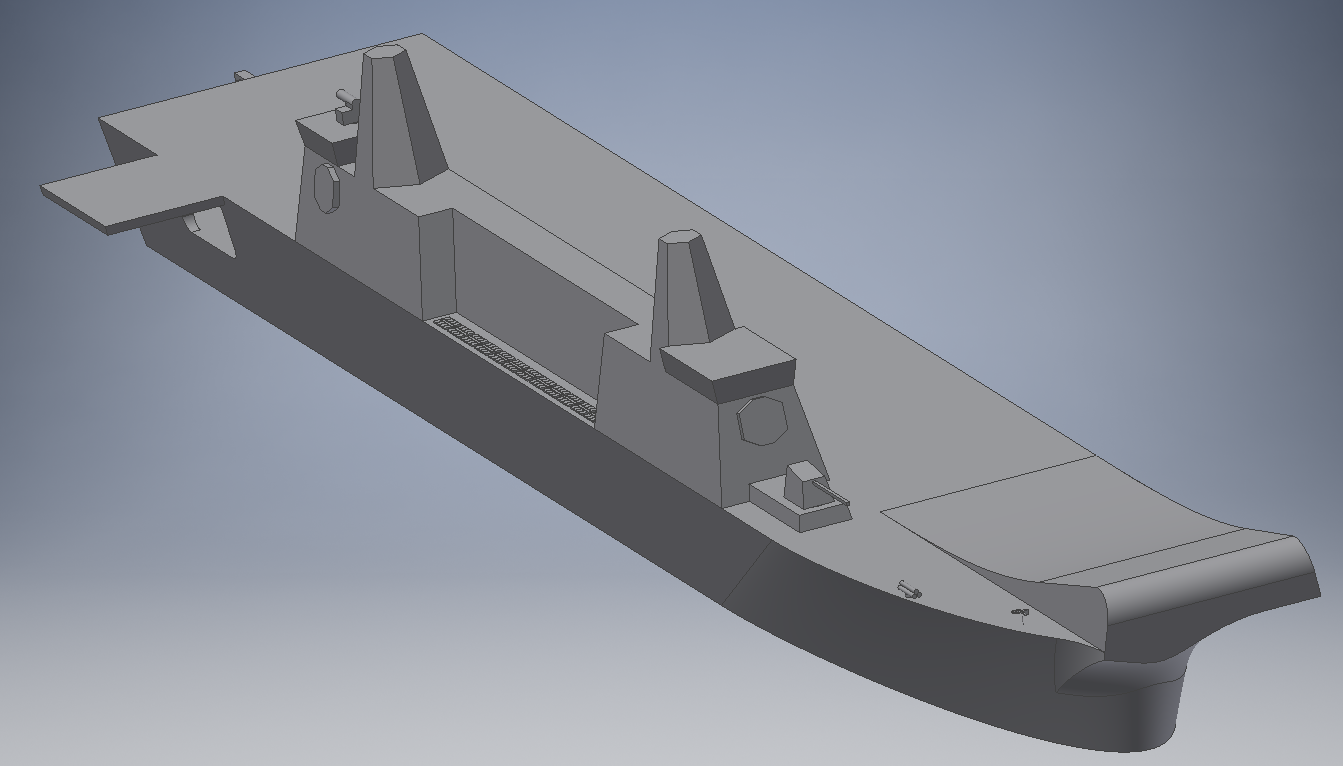
For weapons and sensors, the Flight III Burke can serve as a template. As the most capable Aegis platform in the fleet, it provides an excellent, full-spectrum capability set. This makes a separate escort more redundant than necessary, and also provides vertically-launched land-attack and anti-ship missiles to provide a degree of strike capability. Naturally, it also offers the same type of logistical and industrial advantages provided by the use of the San Antonio hull.

With these design decisions, the author built a 3D model of the concept ship to improve granularity and assess the layout. Most notably, it is possible to wrap the superstructure around the vertical launch system (VLS) to shield the flight deck from exhaust, or more importantly, foreign object debris, avoiding serious conflict between missile launch and flight operations. This model also demonstrates that it is possible to fit enough hangar capacity for an air wing of 12 F-35Bs, 12 MH-60Rs, 2 MQ-8Cs, and 1 MV-22 to provide persistent air cover, plus a few extra utility aircraft. Furthermore, while the vast majority of the San Antonio’s amphibious capabilities would obviously be eliminated, the model shows that it is possible to leave a reduced-height well deck to support UUV, USV, and small boat operations if desired. These sea launch capabilities are a particularly notable example of the need for prototyping, because testing may show the need to remove the well deck or replace it with another type of launch facility or critical spaces.
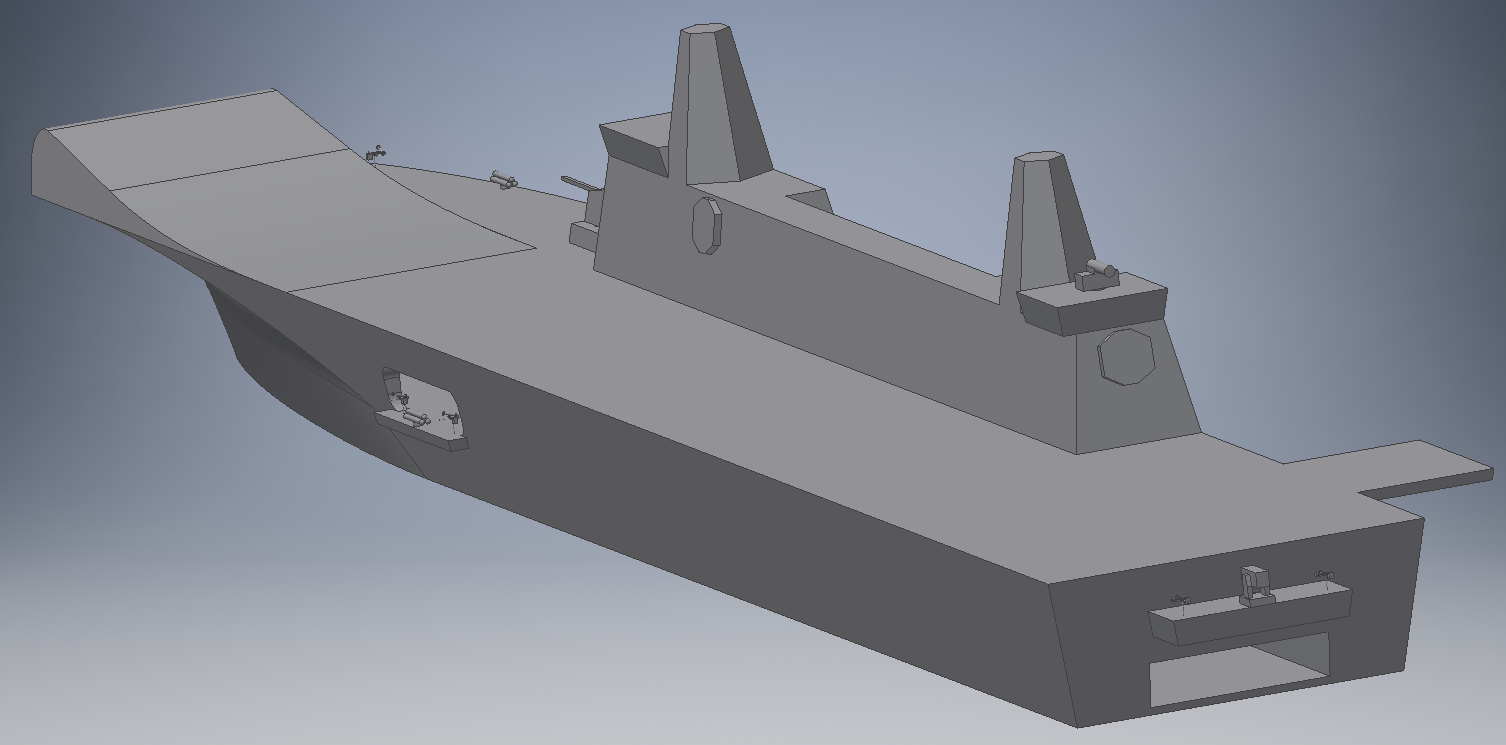
The notional armament is 96 Mark 41 vertical launch cells, a Rolling Airframe Missile launcher, two Mark 32 triple torpedo tubes, a laser, a railgun or 5-inch gun, and five Javelin/Browning pintle mounts. Anti-ship missiles are launched from the VLS or embarked aircraft instead of top-side mounted launchers to improve upgradeability. The bridge is also clearly visible on top of the forward end of the superstructure, as is Primary Flight Control at the aft end, which protrudes over the sloping superstructure to provide excellent visibility of the flight deck without interfering with flight operations. Finally, it is possible to retain a small portion of the San Antonio’s infantry capacity for EABO and special operations support.
The larger America-class amphibious assault ships, the commonly discussed example in light carrier concept discussions, are not well-suited to serve as a basis for this concept. Most notably, while they carry more aircraft, the incremental improvement is not enough to provide a major step-change. An America-class hull configured in this manner would likely provide an additional six MH-60Rs and four F-35Bs. The extra anti-submarine helicopters would allow three of these aircraft to be airborne at all times, but this does not provide a dramatic performance improvement because the Sea Control Ship demonstrated that two are adequate to maintain sonobuoy barriers on both sides of a convoy for early warning of submarines. The additional F-35Bs are not enough to increase the standing combat air patrol from two to four, so the additional aircraft would functionally provide a reserve force that could either be held to respond to threats or sent on small strikes without compromising top cover. While that is certainly useful, as are the larger magazines and fuel storage allowed by a larger hull, the America costs an additional $1.5 billion and hundreds of crew, a one third-to-one half increase in cost to $4.5-5.5 billion for limited gains. One final point that applies broadly against a larger hull is that in any environment dangerous enough to require a doubled air wing, carrying it in two smaller hulls with full defensive suites provides a major survivability advantage.
With all that said, it is still worth examining the cost to rebuild the USS Bonhomme Richards (LHD-6) as a prototype carrier of this type. Since the ship would require a new, much larger superstructure to house the weapons and sensors, the old superstructure and underlying structure would have to be completely replaced regardless, making the extensive damage there irrelevant. That could make the rebuild more affordable since it would be competing with a new-build prototype, and it would allow the Navy to act more quickly on the stated goal of acquiring small carriers without the risks associated with developing a new class of ship.
Costs and Benefits
The next step is to examine this design’s impact on the Navy. The San Antonio and Arleigh Burke each cost around two billion dollars, so it is reasonable to assume that the overall cost of this hypothetical ship will be in the $3-4 billion range after accounting for the savings from eliminating duplication and the extra cost of the aviation equipment. The San Antonio and Burke have about 300-350 crew each, so this ship will probably need about half-again (500 personnel). With the addition of air wing personnel, the crew complement increases to a total of roughly 800. Crew count could likely be reduced from this number with modern automation technology, as was done on the Zumwalt-class destroyer. However, it is difficult to automate aircraft maintenance, so a crew of less than 500 seems unlikely. Finally, it should be noted that this cost represents a complete task force since no separate escort is required. That said, it does omit the optional ground combat element in the crew count and makes no attempt to address logistics requirements due to the complex interactions with the rest of the fleet.
While that cost is substantial, this hypothetical ship does offer plenty of capability which might justify the investment. As an escort, the aerial targeting information from its F-35Bs will make it much more capable than traditional surface combatants against most surface and air threats, while its large helicopter complement offers similar advantages for anti-submarine warfare. Defensive employment would be similarly effective for closing chokepoints to enemy movement, and would be particularly effective against submarines since it could maintain an extensive drone and sonobuoy field. They could also be used to support distributed operations in a variety of ways, such as forming a distant screen to expand overall situational awareness or supporting expeditionary operations with forward air cover and light sealift.
Alternatively, they could conduct a variety of special operations from a single hull by backing up ground elements with organic airlift, air support, and missile strikes. Finally, the use of common systems means they could easily be incorporated into any conventional task force to provide additional mass, although they are not particularly efficient in this role. In peacetime, these ships would offer flexibility to the fleet because they could fill in for essentially any kind of ship needed, provide a distributed rapid reaction capability, carry the diplomatic prestige of being an aircraft carrier, and free supercarriers from low-end operations. When everything is said and done these benefits may not outweigh the costs, but it should illustrate how rethinking a small carrier’s mission set can lead to interesting alternative solutions.
This concept may also benefit international navies. Since these ships would cost substantially less than a fully escorted carrier, they may appeal to smaller navies that may be unable to afford super carriers and may be willing to sacrifice some capability to reduce cost. For example, Norway might choose to replace the Helge Ingstad with a ship of this type since they already operate the F-35. This would more than fully replace its defensive capabilities while adding unprecedented power projection, giving them much greater capability. Politically, acquiring an aircraft carrier would be a dramatic signal of intent and commitment to defense out of proportion to its cost, and would go a long way toward addressing longstanding tensions with the U.S. over NATO spending.
Finally, it is important to reiterate that this is only one possible outcome. The Sea Control Ship concept would also be a valid application of this reduction in mission scope, and there are plenty of other alterations to explore. Similarly, the concepts presented using a small aircraft carrier are just as applicable in other contexts. The output may be unexpected and may need to be integrated with other platforms or concepts to be truly viable, but it can open up alternative solutions to bypass seemingly impossible problems.
Ben DiDonato is a volunteer member of the NRP-funded LMACC team lead by Dr. Shelley Gallup. He originally created what would become the armament for LMACC’s baseline Shrike variant in collaboration with the Naval Postgraduate School in a prior role as a contract engineer for Lockheed Martin Missiles and Fire Control. He has provided systems and mechanical engineering support to organizations across the defense industry from the U.S. Army Communications-Electronics Research, Development and Engineering Center (CERDEC) to Spirit Aerosystems, working on projects for all branches of the armed forces.
Featured Image: The amphibious transport dock ship USS San Antonio (LPD 17) steams through the Red Sea June 16, 2013. The San Antonio was part of the Kearsarge Amphibious Readiness Group and was underway in the U.S. 5th Fleet area of responsibility supporting maritime security operations and theater security cooperation efforts. (Photo via Wikimedia Commons, by GySgt Michael Kropiewnicki)

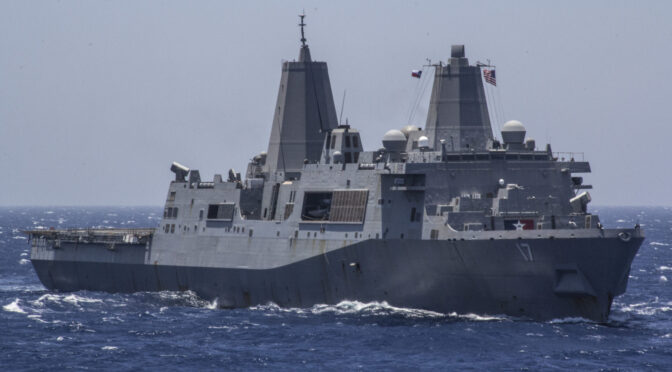
Ben,
Excellent article and very thought-provoking!!!!
Just a question (from an interested layman):
Your proposed high-level escort carrier design seems to imagine a ship of much more power/capability than any cruiser. Was just wondering, given the capabilities of the proposed ship, whether this ship would also provide the Ticonderoga cruiser replacement strategy that the Navy is struggling with? Certainly from a budgetary perspective such an idea, if feasible, would seemingly provide an extraordinary incentive.
The only proposed design item that might cause an issue that I could see would be the top speed recommendation, since a cruiser replacement would need to be able to keep up with the super-carriers.
Would be interested in your thoughts!!!
A carrier predominantly used for, or even dedicated to, UAVs and lilypad operations would not need to be very large, nor would its survivability be so critical.